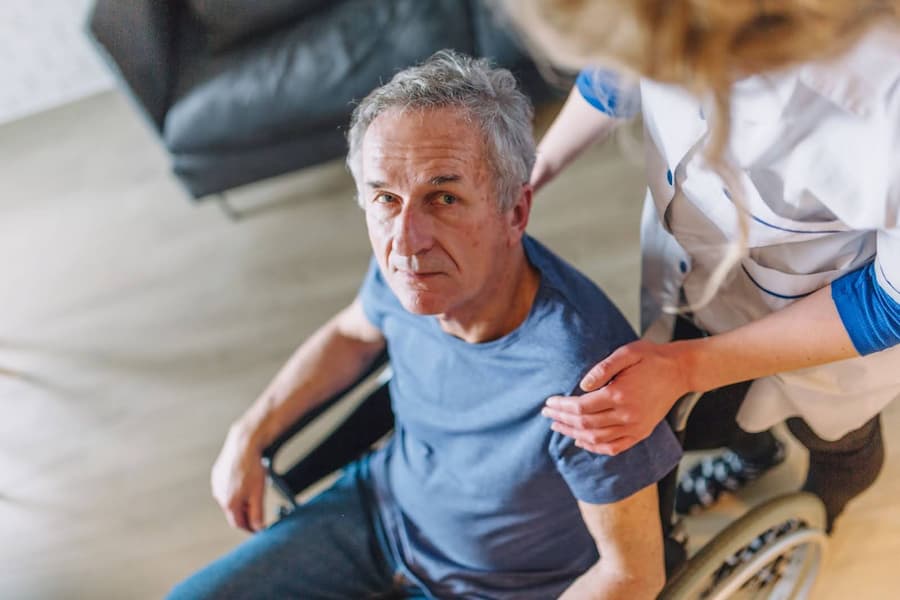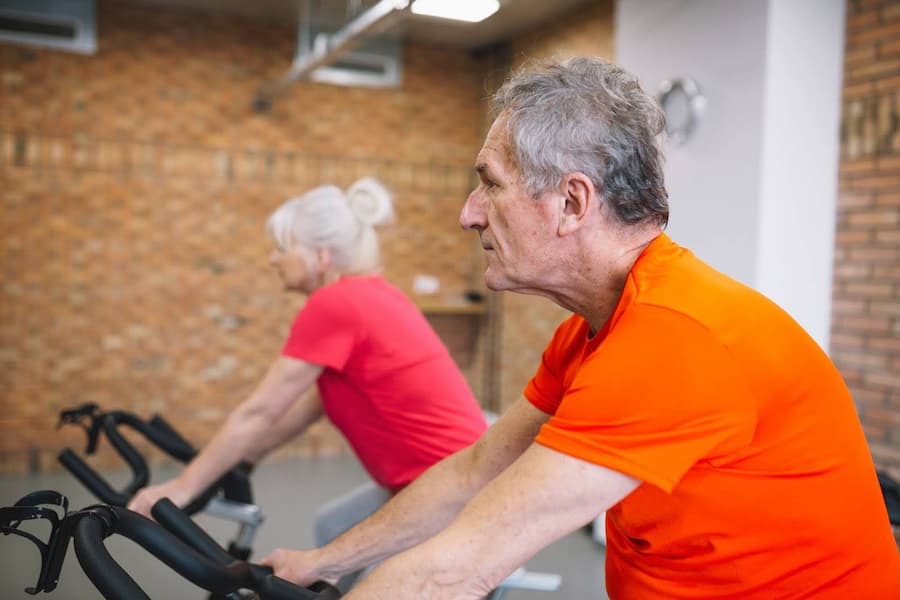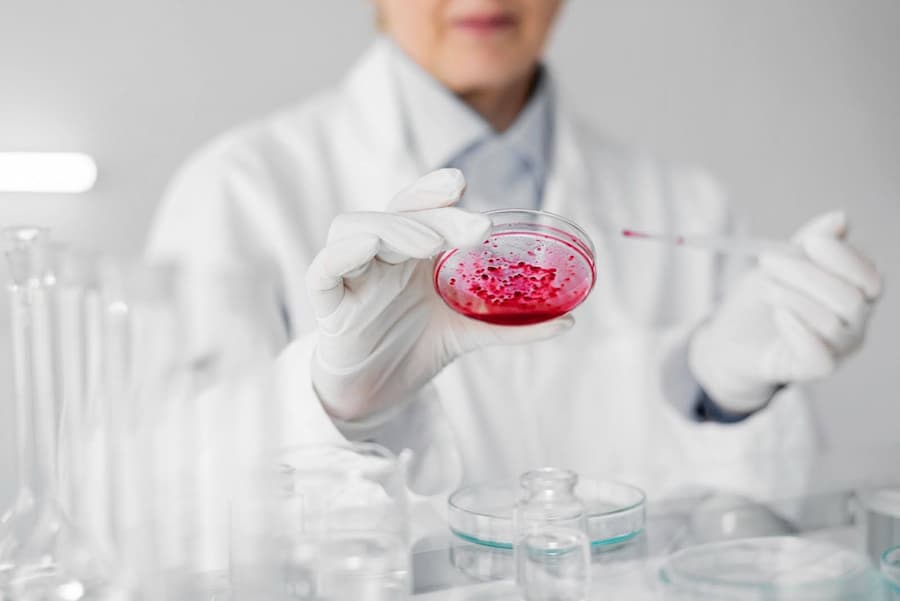600,000 of the approximately 800,000 Americans who have strokes each year are experiencing their first one. A stroke is one of the five most severe medical illnesses. It damages the main or peripheral blood vessels in the brain, and it can cause malfunctions in specific body parts or the entire body.
A person’s body and daily routine can change significantly after a stroke. For instance, breathing, blood pressure, and hormonal responses are all regulated by the brain. Some or all of these functions may be partially “blocked” or permanently lost after a stroke.

The majority of strokes occur in people over the age of 60 or 70. It means that the danger of such a condition increases in older people.
What Is Stroke Rehabilitation?
Rehabilitation for stroke patients focuses on restoring blood flow to damaged areas of the brain and body. Patients must return to a sufficient standard of living and frequently struggle with routine tasks such as dressing, eating, and using the restroom due to post-stroke complications.
Goals of Stroke Rehabilitation
A stroke affects not only the affected areas of the brain but also how the body functions. Stroke rehabilitation must begin immediately following the incident. Hours count, and post-stroke symptoms can emerge quickly.
- Physical implications include impairment or loss of control on one side of the body, as well as localization in smaller portions. For example, it could be a lack of muscle movement or the advent of unusual feelings in the body.
- Cognitive effects: it can have an impact on memory work, perception quality, and problem-solving.
- Emotional impacts include difficulties managing emotions, expressing inappropriate emotions in various settings, and developing sadness, anxiety, and feelings of isolation.
All types of this condition require extensive rehab for stroke patients. There are few conservative rehabilitation approaches, but the basic goal is the same: reduce disability by aiding the recovery of impairment, activity, or participation.
According to research, the most important factors influencing outcomes and results are the number of minutes spent in therapy, the frequency of rehabilitation (the number of days per week), and the duration of rehabilitation.
More detailed strategies for stroke rehab programs include the following aspects:
- Improving physical function and mobility.
- Increasing independence in daily activities.
- Reducing the risk of future strokes.
- Improving communication and cognitive abilities.
- Addressing emotional and psychological issues related to stroke.
Improving Physical Function and Mobility
Physical impairment is one of the most impactful effects after a stroke, together with a loss of muscle strength and coordination problems. The goal of regaining motor function is to achieve independence in daily living and a satisfactory quality of life.
There are certain guidelines for physical therapy for stroke rehabilitation that can partly or fully restore mobility and motor functions such as walking, sitting, or staying, lifting weights, or even brushing teeth:
- motor training under the therapist’s guidance and homework;
- walking training starts with a short time and gradually becomes longer;
- task-specific exercises conducted with a therapist at home or in a clinic;
- reducing inactivity during the day of a patient.
These trainings should be regular and oriented for long periods—from a few months up to a few years.
Increasing Independence in Daily Activities
Independence in usual tasks during the stroke rehabilitation period should start immediately based on neuro- and physical training. It is called occupational therapy—patients are given exercises to do in and out of bed during the day that assist them in relearning daily skills such as eating, drinking, swallowing, dressing, bathing, cooking, reading, and writing.
Some occupational therapists recommend making changes to the individual’s home or workplace to help them live an independent or semi-independent lifestyle again. However, these recommendations may not be effective.
Reducing the Risk of Future Strokes
If someone has had a stroke before, they are more likely to have another one. Recommendations for preventing future strokes primarily concentrate on caring for patient’s emotional and physical problems, as well as medical therapy:
- Regular attention to a person’s basic needs: enough sleep, a good diet, daily movement, sports, and balance in work and private life to reduce stress and burnout.
- Restoring blood flow in injured parts of the brain through physical and cognitive therapy administered by a therapist;
- thrombolytic and antithrombotic medical support—drugs that dissolve blood clots that block blood flow to the brain, preventing further brain injury from the stroke.
A patient needs to consult with a specialist and follow the plan to achieve a partial or full restoration of functions.
Improving Communication and Cognitive Abilities
People after a stroke often have difficulties communicating with people, solving basic and work tasks, and may struggle with the quality of their attention and memory. It affects the productivity of a person and his or her emotional condition and should be included in strategies for recovery after stroke.
The recovery could include special neurotraining for the following processes:
- memory—short- and long-term;
- thinking and planning;
- speech, reading, and writing;
- concentration and attention;
- critical and analytical skills.
10% of stroke survivors feel mood swings and emotional lability, which can be long-term and affect the whole lifestyle of a person. There are also people experiencing troubles with self-esteem and self-confidence as soon as they depend on their relatives and specialists during recovery after stroke.
Get a free online consultation
Please, contact our medical advisor to discuss your health condition with a specialist in regenerative medicine. You can also leave your contact details for a callback. It is free and confidential.
Types of Stroke Rehabilitation
Strokes are categorized into three categories, each with a unique mechanism and recovery after stroke.
- Ischemic strokes occur when blood clots and fatty deposits, sometimes known as aqueous, clog numerous arteries.
- Hemorrhagic strokes occur when blood from an artery quickly flows into the brain, causing loss of control of body parts connected to the afflicted brain areas.
- Transient ischemic episodes (TIAs), sometimes known as “mini-strokes,” are transient disruptions of brain blood flow that last no longer than 5 minutes.
The recovery period is generally longer for hemorrhagic strokes, lasting for months or even years, compared to ischemic strokes. While the initial prognosis and recovery timeline may differ, ischemic and hemorrhagic stroke patients can ultimately achieve similar functional outcomes.
Most people with small hemorrhagic strokes and no additional complications are able to function well enough to live independently, but the recovery can be slower.
The most common way of treating an ischemic stroke is to restore blood flow to the affected region by using thrombolytics or mechanical devices that physically remove clots. The thrombolytic effect is limited due to a therapeutic window of several days or even just a couple of hours after the onset of stroke symptoms, and that is the reason why only a small percentage of patients receive the required therapy.
Physical therapy and medicine are used to restore lost functions in long-term therapy, but the results are not guaranteed.

Physical training has long-term, consistent benefits for stroke survivors.
Physical therapy that focuses on improving mobility and strength through exercises and activities
Physical exercises are recommended for each type of stroke after 24–48 hours of the incident. A physical therapist controls the load level, which is dependent on individual conditions. We already mentioned the types of activities that are used in conservative stroke rehab, and here we will share some proven strategies:
- Physical therapy for motor rehabilitation includes an individually designed set of exercises for home practice and clinic-based therapy. A focus should be on regular and smooth prolongation of activities and movements, depending on after-stroke effects and disabilities.
- Mobility training. In cases of total loss of motor and muscle control, it is recommended to use wheelchairs, canes, or other mechanical support for daily movements.
- Robot-assisted neurorehabilitation exercises are one of the new methods for physical training that use robots to restore muscle strength and limb function. Patients receive this type of therapy at stroke rehabilitation centers.
- Range-of-motion therapy. This method uses special exercises to restore full movement and reduce muscle hypertension or hypotension. It applies gradually after base treatments and has good results in the restoration of basic movements.
- Vagus nerve stimulation combined with mobility training can be helpful for people with impaired upper limb and extremity motor function. The vagus nerve runs from the brain down to the abdomen, and it is stimulated electrically to improve upper limb and extremity motor functions and hand and arm movement.
Occupational therapy that helps people regain independence in activities of daily living such as dressing, eating, and bathing
A significant portion of life involves routine tasks, and when we are unable to perform certain basic ones, it can affect our emotional and general well-being. Physical therapists are advised to employ task-specific activities while treating rehab stroke victims.
For instance, there may be a unique series of exercises for operating a car, sitting and standing, and eating rituals. It is critical to comprehend a patient’s daily needs and incorporate activities that raise the functional degree of these abilities.
Speech therapy that focuses on improving communication and swallowing abilities
Impairments of speech (aphasia, dysarthria) and swallowing disorders (dysphagia) often occur after a stroke. Groups of muscles and nerves in the neck are responsible for these functions, and speech therapy is important for rehab for stroke patients.
Speech therapy activities can help patients relearn language, improve their speaking skills, or explore alternate communication options such as coping techniques to help them overcome the frustration of communication obstacles. It is appropriate for those who have no problems with cognition or reasoning but struggle to grasp spoken or written words or have difficulty articulating speech.
Cognitive rehabilitation that helps people regain cognitive functions such as memory and problem-solving skills
Stroke can significantly impair memory, attention, and problem-solving abilities. Cognitive rehabilitation involves exercises that are related to a patient’s everyday activity, such as counting, writing, recalling knowledge, and inventing something new.
Research has revealed that there is a link between cognition—particularly executive function and attention—and motor recovery, demanding an emphasis on cognitive components during rehabilitation.
Many people suffer from anxiety, frustration, mood changes, and despair following a stroke. Patients can benefit from psychological or psychiatric therapy during their stroke recovery process.
Therapy, in conjunction with medicine, can help patients control their emotional state, allowing them to adapt their ideas and understand physical changes. It is also crucial for their relatives to receive such assistance, as caring for a post-stroke relative can be overwhelming.
Stem cell therapy
Stem cells have been studied and employed in rehabilitation for over 40 years. These cells can convert into other types of cells, but the majority of their work occurs throughout childhood.
Studies have shown that different types of stem cells can enhance neurological skills following a cerebral stroke. They have the ability to differentiate into neurons and glial cells, and reduce inflammation, which can further damage the brain after a stroke.
Stem cells are usually administered intravenously. After that, they circulate in the blood until they become attracted to proteins found around inflamed or damaged tissue. Restoring damaged brain functions leads to higher chances of recovery after a stroke.
Stem cell treatment is a safe process that can begin immediately following a stroke if there are no contraindications. And when combined with more conservative rehabilitation procedures, stem cell therapy produces faster outcomes.
Here are some of the positive impacts of adult stem cells on the body for stroke rehabilitation:
- Activation of the own stem cell pool and its regenerative capacity;
- Neoangiogenesis—stimulation of the growth of new blood vessels;
- Inhibition of autoimmune aggression;
- Improvement of neuromuscular conduction, which means restoration of motor functions and connection between the brain and body;
- Anti-inflammatory and immunomodulating effects.

At Swiss Medica, we do not use embryonic stem cells in our therapies. Instead, we utilize adult, or mesenchymal stem cells, which are safe for the health of patients.
In most cases, they are collected from donors, primarily from the umbilical cord or placenta, but also from adipose tissues or bone marrow. Placentas and umbilical cords are harvested as they are discarded after childbirth in a sterile setting, minimizing the danger of contamination.
After harvesting, stem cells are examined to guarantee purity, viability, and sterility. This includes extensive examinations for bacterial, fungal, and viral contamination, as well as genetic and molecular tests to establish their identity and functionality.
We have created therapy regimens to assist stroke patients in regaining their basic needs for movements and normal tasks. Our medical experts gather your medical records and conduct medical tests before going ahead with stem cell therapy to prevent any side effects.
Read more about the stem cell therapy process at Swiss Medica, including testimonies and pricing, in our dedicated article.
Rehabilitation Timeline
Rehabilitation for stroke patients should begin as soon as possible, at least 2-4 hours after the incident occurred. Still, many people do not call an ambulance or even go to the doctor, which contributes to the growing number of invalids or people at risk of disability.
Here is the fundamental timetable, which is more typical in cases of ischemic or hemorrhagic stroke.
First Weeks After Stroke
If you have had a stroke, you should immediately call an ambulance to have your condition checked and stabilized. In hospitals, doctors can order examinations, such as
- CT and MRI are used to identify the location and kind of circulation abnormalities.
- Carotid artery Doppler ultrasonography.
- Transcranial Doppler Ultrasound.
- MRI and cerebral angiography.
- Heart ECG.
- General and biochemical blood tests.
After all the examinations, together with specialists, you can build a customized stroke rehab program that includes the following methods and therapies:
- Medication to prevent future strokes and improve blood circulation throughout the brain and body.
- Physical therapy should be provided regularly in the clinic to establish some exercises for home practice and to prevent or restore the function of various muscles or joints that may be damaged.
- Cognitive therapy and psychological support will help you comprehend your situation and take the appropriate steps toward rehabilitation.
1–3 Months After Stroke
After a few days or weeks in the clinic, patients return home and begin their stroke rehab program based on doctors’ advice and prescriptions. This interval is also critical for achieving complete rehabilitation or, at the very least, lowering the danger of losing control of the body’s or brain’s functions.
It is all individual, but studies have shown that if patients followed all guidelines for food, day-to-day activities, and connections with others, they would have better results: a less stressful atmosphere, regular exercise, a good diet, and relationship building.
Communication is a key aspect of rehabilitation, and if a patient receives support from relatives, there is a better possibility of restoring brain and body functions and preventing future strokes.
3+ Months After Stroke
Long-term therapy following a stroke should last several months or years, depending on the individual’s condition and the side effects that occurred. To summarize, you should visit a physical therapist and a neurologist regularly to correct or reduce drugs, enhance your daily activities to regain a complete range of motion in the body, and balance your professional and personal life to avoid excessive stress.
Contact us
Get a free online consultation to learn about the expected results of stem cell therapy for your case, what is the cost of the treatment, and its duration.
List of References:
National Institute of Neurological Disorders and Stroke. https://www.ninds.nih.gov/health-information/disorders/stroke#toc-who-is-more-likely-to-have-a-stroke-
Clark B, Whitall J, Kwakkel G, Mehrholz J, Ewings S, Burridge J. The effect of time spent in rehabilitation on activity limitation and impairment after stroke. Cochrane Database Syst Rev. 2021 Oct 25;10(10):CD012612. doi.org/10.1002/14651858.CD012612.pub2
Kwakkel G, Stinear C, Essers B, Munoz-Novoa M, Branscheidt M, et al. Motor rehabilitation after stroke: European Stroke Organisation (ESO) consensus-based definition and guiding framework. Eur Stroke J. 2023 Dec;8(4):880-894. doi.org/10.1177/23969873231191304
Gibson E, Koh CL, Eames S, Bennett S, Scott AM, Hoffmann TC. Occupational therapy for cognitive impairment in stroke patients. Cochrane Database Syst Rev. 2022 Mar 29;3(3):CD006430. doi.org/10.1002/14651858.CD006430.pub3
Mac Grory B, Yaghi S, Cordonnier C, Sposato LA, Romano JG, Chaturvedi S. Advances in Recurrent Stroke Prevention: Focus on Antithrombotic Therapies. Circ Res. 2022 Apr 15;130(8):1075-1094. doi.org/10.1161/CIRCRESAHA.121.319947
Egan M, Laliberte Rudman D, Lanoix M, Meyer M, Linkewich E, Montgomery P, Fearn J, Donnelly B, Collver M, Daly S. Exemplary post-discharge stroke rehabilitation programs: A multiple case study. Clin Rehabil. 2023 Jun;37(6):851-863. doi.org/10.1177/02692155221144891
Bui KD, Johnson MJ. Designing robot-assisted neurorehabilitation strategies for people with both HIV and stroke. J Neuroeng Rehabil. 2018 Aug 14;15(1):75. doi.org/10.1186/s12984-018-0418-3
Kimberley TJ, Prudente CN, Engineer ND, Dickie DA, Bisson TA, Van de Winckel A. Vagus Nerve Stimulation Paired With Mobility Training in Chronic Ischemic Stroke: A Case Report. Phys Ther. 2023 Dec 6;103(12):pzad097. doi.org/10.1093/ptj/pzad097
Mullick AA, Subramanian SK, Levin MF. Emerging evidence of the association between cognitive deficits and arm motor recovery after stroke: A meta-analysis. Restor Neurol Neurosci. 2015;33(3):389-403. doi.org/10.3233/RNN-150510
Permana AT, Bajamal AH, Parenrengi MA, Suroto NS, Lestari P, Fauzi AA. Clinical outcome and safety of stem cell therapy for ischemic stroke: A systematic review and meta-analysis. Surg Neurol Int. 2022 May 20;13:206. http://doi.org/10.25259/SNI_1174_2021
MD, Endocrinologist, Pediatrician, regenerative medicine specialist, R&D director








